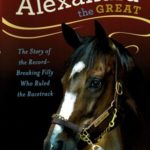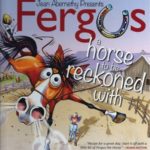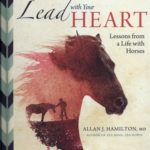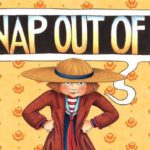I was out at my barn cleaning stalls on a warm spring day. While mucking, picking and scraping, I noticed a huge tour bus pull into the development next to ours where three houses are for sale.

Many of the Chinese businessmen had cameras. I could see them standing at my upper pasture?s fence line, adjacent to the homes, shooting pictures of my horses grazingin the green spring pasture while I was filling my manure spreader.
Before taking my piled manure spreader to the upper pasture, I went into the tack room, dusted off my old felt cowboy hat, and put it on and then climbed on my tractor to spread the manure. As soon as the tourists saw that hat on my head, all eyes were on me as I rode my tractor. Their real estate agent asked me politely if they could take my photowith my tractor and horses in the background. Sure, why not?
I guessed that it was my hat that caught their attention and completed the picture, imagining the caption in my head, ?American cowgirl at horse ranch with tractor.? I only wished I was riding instead of mucking!
The businessman asked whether it was my ranch. After replying ?Yes,? he asked why I was doing the chores, not a worker. I told him that I loved cleaning my stalls ? ?It’s my ?thinking? time of the day.? His reply, ?Ahh, you Americans ? always doing your own work!? Ha! I was glad to have represented my people this way ? I think!
Anyway, this got me thinking about my old felt hat. Is there any other American clothing item that holds such romantic symbolism, immediately recognizable globally, besides the cowboy hat?
History of the Hat
Some hat historians think the evolution of the cowboy hat started with the nomadic warriors called Mongol hordes riding small, very fast horsesin the 13th and 14th centuries. The Mongols were great horsemen. When they set out to invade Europe, they were mostly unsuccessful, but their felt hats with broad, wide brims were adopted by the Spaniards, who eventually brought the wide-brimmed design to Mexico where the vaqueros, working on the cattle ranches, adapted the style into sombreros.
For the material, some say that felt also originated from the Mongols. It is the oldest form of cloth known, as the matting process predates weaving.
Legend points to John the Apostle designing the first felt wide-brimmed hat. It is said that while traveling the world to spread the word of God, because he was a fisherman by trade, his sea-loving feet were not used to land. To ease the discomfort, he started gathering the tufts of wool that the rams left behind on bushes and placed the wool in his sandals. Eventually, the wool hardened and matted together under the weight of his feet and warm dampness of sweat.
How did the wide-brimmed hat come to the west?
It’s said that the first Americans to travel west into Texas combined the slouch hat of the southern planter with the sombrero and came up with a floppy brimmed, high-crowned hat. American cowboys wore variations of this hat.
?This country was built on that hat,? says Chip Alexander of American Hat Co. in Bowie, Texas. ?Our nation expanded when fur trappers led the way. They opened up the Ohio Valley leading to the French and Indian Wars bidding for trapping rights and later into the Rocky Mountinasopening the frontier trails for the pioneers heading west. The demand for beaver fur hats was high in the courts of 18th century Europe, and the American fur trapping trade was strong. When pioneers started the long trek across the prairie, it was the broad-brim hat protecting them along the way. The demand for beef became so strong in the East it became worthwhile to drive herds of cattle from Texas up to the trailheads in Dodge City, Kansas. It was the broad-brim hat protecting the cowhands from the harsh sun and rain. It stuck with the horseman because this kind of hat was practical for so many reasons.?
John B.?s Brim
Many credit John B. Stetson with making the first true ?cowboy hat.? John Batterson Stetson, born in 1830 to a New Jersey hat maker, followed in his father?s shoes as a hatmaker himself. In his early 30s, he was diagnosed with tuberculosis, so in the 1860s, he left the hat-making business and traveled west, thinking this would be his last chance for adventure and hopefully improved health.
I found many variations on Stetson?s story. Many agreed that while on a hunting trip, he decided to show his buddies how to make a blanket of felt from animal fur with the goal of creating a hat that would protect him from the weather. Using beaver and rabbit fur, he created felt through the ancient process he had learned from his father by shaving the fur off animal hides, mixing the fur and spraying water over it until it became matted. Then he dipped the mixture in boiling water. As it began to shrink, he squeezed out the water until he had a thick mat of felt.
He shaped the felt into an unconventionally, religiously huge hat that could protect from intense sun, driving rain, wind and sleet. He wore it on the hunting trip. Shortly after he made the hat, the story is that a passing frontiersman on a striking stallionsaw Stetson wearing his big hat and offered him $5 for it. Stetson gladly sold it.
When he returned to Philadelphia, he kept ?seeing? the horseman astride his stallion in the big hat. His enterprising mind decided that the booming cattle industry?s barons would enjoy such a hat. So he made more of them and eventually this hat became known as ?The Boss of the Plains.? His ?Stetson? became so popular it allowed him to start the John B. Stetson Co., one of the largest hat firms in the world.
?The bigger, taller open crowns were popular in the northwestern states, allowing for more air space to keep the head warm in colder climates,? says Lance Brewer, hat seller and shaper in Bothell, Washington. ?The shorter crowns with a cattleman?s crease and wide brim were more popular in the southwestern states.?
The Stetson hat became a symbolof quality, and soon western icons such as Buffalo Bill Cody, Calamity Jane, Will Rogers, Annie Oakley and Tom Mix were donning a Stetson. The hat even became a required part of the Texas Rangers uniform.
?Even back then, it would have cost a whole month?s wage to get a hat that was well made,? says Lavona ?Shorty? Koger of Shorty?s Caboy Hattery in Oklahoma City. ?But the cost was worth it. The hat could shield a cowboy?s eyes from the blinding sun or catch the rain before it ran down his back.?
Modern Hats
As time passed into the 20th century, the cowboy hat’s popularity gained momentum on the heads of Hollywood cowboys from Roy Rogers, Dale Evans and Gene Autry to John Wayne and Clint Eastwood. All the while, working cowboys continued their love affair with their hats.
?All working cowboys used to know how to ?twist a lid? (shape their own hats). It was part of owning one,? Lance says.
Wannabe cowboys wanted hats, too.
?Cowboys would buy the best hat they could afford because they planned on having it for a long time. As the western movie era arrived, hats started to become a fashion statement even for people who didn’t know the first thing about a horse ? they could still look the part,? says Joel Gleason of Avila?s Pro Shop in Pablo, Montana.
Styles have changed, but the way a hat is made is the same. The fur felt is made from a variety of animal fur but the beaver is by far the best with its water-repellent qualities. Straw hats offer an affordable and cooler summer option, Panama straw being the best.
From then to now, American Quarter Horse enthusiasts from rodeo cowboys to women?s drill teams, from barrel racersto horse show competitors, from trail riders to working ranch hands continue to cherish their beloved cowboy hats.
Shapes in the Show Ring
?The western hat is a distinguishing component of every rider?s outfit,? says Chip. ?It can be color-coordinated with the rider?s outfit, but unlike the rest, the western hat can also be custom-shapedto express the individuality of the rider.?
Sometimes, that individuality is shaped by location.
?Today, hats that appear in the show ring are still being heavily influenced by tradition,? says Ritch Rand of Rand Custom Hats in Billings, Montana. ?More so than what is seen just outside the ring. The regional shapes in this case tend to give way to the more traditional cattleman crease and longhorn-type brim, although we are seeing more ?Junior Brown?-type brims (taco) on younger competitors. Crowns still tend to be lower, especially in Texas and Oklahoma, with ?shovel front?-type brims giving way to round and broader creases in front ? especially in team roping and roughstock. Lots of contrasting bound edge work outside the arena ? less inside the show ring. The reasons are pretty standard: Don?t take the attention from you and your horse’s performance.
Shape trends have changed through the years, as have ornamentation trends.
?Years ago, it was tall crowns with short brims and now, it is short crowns with wider brims,? Shorty says. ?Many of our clients who show on a national or World Show level are wearing deep, rich-colored hats. We have added embroidery work and crystals for a touch of elegance and bling. Exotic hide overlays have also entered the ring, with clients wanting and willing to make a statement.?
AQHA Hat Shapes
Your hat can let people know at a glance which event you compete in? and how well you’re doing.
?For all horse-show classes, including halter, showmanship, pleasure and reining, it’s the ?feed scoop shape? or ?taco shape? ? squared in front, rounded in the back,? Joel says. ?For cattle classes, such as cutting, working cow horse and roping, the shape is flatter in the brim, squared in front but wider than the horse show classes. When you see someone at a horse show, no matter what the shape, if their hat is shaped nice with that fresh brushed look, you are usually looking at a successful person because they pay attention to detail.?
A good fitis paramount.
?As a critical part of each rider?s outfit, the hat can be fitted and shaped to the wearer,? Chip says. ?A good hat shaper will crease the hat crown to the wearer?s face, shape the sides up or down, and even trim the brim down. Some look better in a 3-3/4 or even 3-1/2-inch brim hat. You can find some of the best hat shapers at the trade shows at many of the larger AQHA events. These hat shapers typically focus on the AQHA competitor, know the current fashion and how to shape to the wearer?s face.?
If you’re new to the show ring, play it conservatively.
?Distractions are a no-no,? Ritch says. He advised men to pick silverbelly or black with a conservative shape and crease and a self-band.
?Contrasting edges in the show ring are a distraction,? he says. ?Women match the outfit, but black is still the new black.?
If it doesn’t look good on you though, ditch the black.
?Black is definitely the most popular color with men, but we always try to fit each client in a hat color that is best suited for the individual,? Shorty says. ?Not everyone looks good in black. It can be very severe, especially on women, and depending on what the person is wearing, it can also make the rider appear shorter than they actually are. In my opinion, I think earth-tone hats look professional and tend to go with a larger variety of outfits.?
Picking Your Hat
You get what you pay for, our hat professionals agreed, but you can improve your chances of getting high quality with these tips.
- Size up your hat by price and quality, using the X-factor as a guide. (More on that below.) If you’re buying a name brand instead of a custom one, get a brand name that’s well-known for quality, such as Resistol, Stetson, Bailey or American. Many times, though, a custom hatter can be competitively priced with name brands.
- Feel the hat for softness. It it’s soft, it’s probably beaver; if it’s coarse, it’s probably wool. Most fur felt hats are made of rabbit which is priced between wool and beaver. Avoid wool because it tends to wilt in hot pickups or in rainy weather.
- Look at your hat. Is the color a deep, true dye or is it uneven?
- Check for density. Thinner felts denote quality, but hats should be firm, too.
- Examine the crease. The shape should be even, without wrinkles or stretch marks.
- Dust for powder. Many shelf hats are powdered to cover up blemishes. If you wear a powdered hat, the powder will come off on your clothes and the hat will become spotted in the rain.
- Test the ?squeeze.? A good felt hat is smooth and resilient. If you squeeze the crown slightly, it should snap back quickly.
- Buy your hat from a qualified buyer you trust, Lance advises.
?You can buy a $50 hat shaped to your face and head, and in the show ring, it will look better than a $500 hat that wasn?t shaped to your face,? he says. ?A hat needs to create balance for the facial shape and bone structure of an individual.?
Besides looking good, a hat can help your performance.
?A good-fitting hat will stay on your head during a lope or when you are cutting or running down the arena,? Ritch says. ?The rules say one must wear a western hat,?? so it would be nice if it fits and will stay on. A hat professional can help you with that.?
X Factor?
There’s a lot of disagreement on the origin of the X value of felt hats. It eventually became an indicator of the amount of beaver in a felt hat. These days, though, the X factor tends to be a marketing tool, Chip says.
?Today, X values in felt hats allow a hat company to offer several quality ranges using different blends of wool, rabbit and beaver furs for a particular price level,? he says. ?Use the X value in a hat as a starting point when shopping for a hat. Then use your own tactile and visual senses as the deciding factor when making a purchase in your budget range.?
In addition to beaver, mink and sable can be used in felt hats, Joel says.
?The rule of thumb is a 20 X hat is 20 percent beaver and 80 percent rabbit,? he said. ?A 100X hat is pure beaver. Above 100X is mink and sable.?
Often, though, one company?s 10X could be equivalent to another company?s 100X. There are no regulations on the marketing of hats.
?Xs are hard to understand,? said Terri Deering, owner of The Hat Lady in Kent, Washington. ?They basically mean nothing. One company?s 10X could be another company?s 100X. The more Xs used to mean better fur, more beaver fur; now it means a better buckle or decoration.?
Caring for Your Hat
Once you?ve paid for your hat, you’ll want to take care of your investment.
?First, always handle the hat by the brim,? Chip says. ?We built it stronger for this reason. Plus, this will keep the crown clean. It is the visible part of the hat. Dirt is the biggest enemy to felt. Using a hat brush to keep it clean will allow it to look new for many years. Remember to always brush it in a counterclockwise direction.?
Remember when we talked earlier about how hats are made by shrinking? That means rain is bad for felt. Don?t get your hat wet, either by letting rain get on it or by sweating inside it. If it does get wet, let it dry naturally.
?If you wear your hat on a hot day and perspire or get it wet, expect it to shrink up some when it dries,? Chip says. ?If you don’t wear the hat for a long time, it can shrink also. You can prevent this by keeping a size maintainer in the hat. These are not hat stretchers, but do keep the sweatband and felt from shrinking up. Of course, the best way to keep your hat fitting well is to wear it. The more you wear it, the better it will fit.?
What’s Next for Our Romantic Icon?
?Although the cowboy hat itself is not trendy, the extra things we embellish it with are,? Shorty says. ?Our show-ring clients continue to be cutting edge. The quality, custom design work and attention to shaping that these competitors are looking for can only be found with a custom hatter like Shorty?s. I feel the trend will continue to be rich color, unique embroidery and crystal work, along with more exotic hides being used. Our clients are also proudly wearing hats and garments that speak loudly for important causes, such as breast cancer awareness. I think you will see more of that, too. So many of their lives have been touched in some way with specific causes; it’s their way of remembering the personal struggles and showing their support by riding for the cause.?
The next style trend might look a lot like an old style trend.
?I don’t know if anyone can tell what the future shapes and styleswill look like in western cowboy hats,? Joel says. ?Shapes just seem to evolve slowly but I have noticed that what was popular 40 years ago is slowly coming back into style.?
Bound edges are becoming more popular, and 1970s styles that were copied from the 1940s are in vogue again, Lance says.
Back to the Past
?The western hat became a symbol of the spirit and pride of the west,? Chip says. ?There is no other piece of clothing making a stronger statement of individual expression than a hat. A hat falls right in with this lifestylejust like the horse and boots.?
It’s a symbol of our past and our present and out future.
?The cowboy hat is known worldwide as American,? Lance says. ?It has varied with time, region and occupation. It has seen as many changes and uses as the cowboys and cowgirls that wear them. From working cowhand, sheriff or banker, rodeo cowboys, country and rock singers, to presidents. And of course there’s those of us who just plain love the horse and the way of life it represents.?
That lifestyle is indelibly American.
?It’s a classic. Whether an individual has ever personally ridden a horse or not, most understand the blood, sweat and tears it took to tame the West,? Shorty says. ?A cowboy hat is the last chance for many of us to be a part of a great adventure. There is truly a magic moment that happens when someone puts a cowboy hat on for the first time. It’s as American as baseball, hot dogs and apple pie.?








